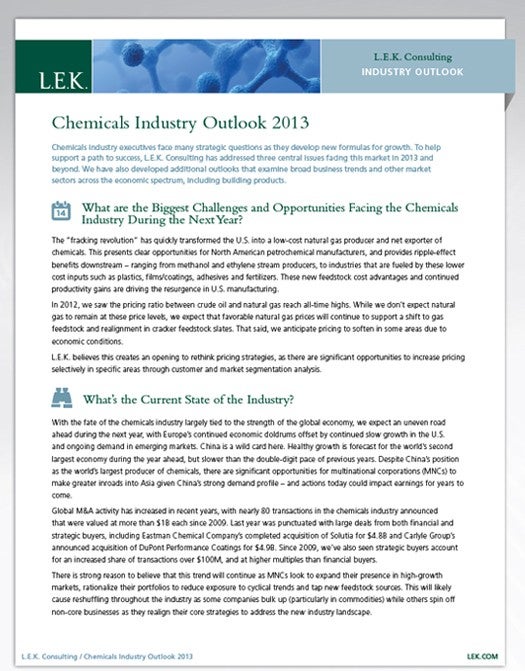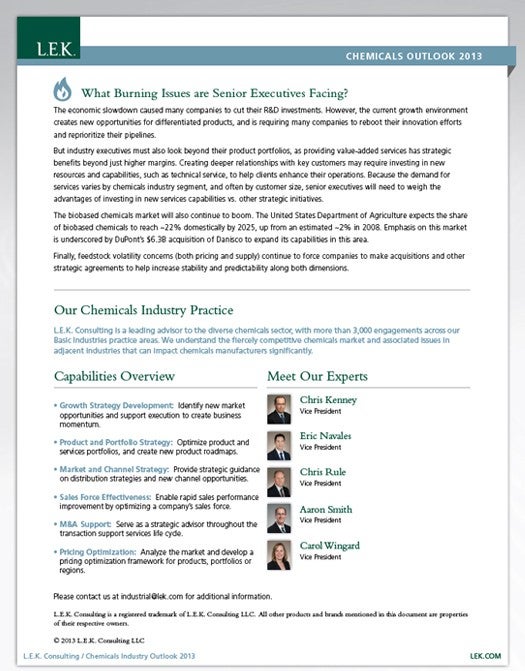
Summary
What are the Biggest Challenges and Opportunities Facing the Chemicals Industry During the Next Year?
The “fracking revolution” has quickly transformed the U.S. into a low-cost natural gas producer and net exporter of chemicals. This presents clear opportunities for North American petrochemical manufacturers, and provides ripple-effect benefits downstream – ranging from methanol and ethylene stream producers, to industries that are fueled by these lower cost inputs such as plastics, films/coatings, adhesives and fertilizers. These new feedstock cost advantages and continued productivity gains are driving the resurgence in U.S. manufacturing.
In 2012, we saw the pricing ratio between crude oil and natural gas reach all-time highs. While we don’t expect natural gas to remain at these price levels, we expect that favorable natural gas prices will continue to support a shift to gas feedstock and realignment in cracker feedstock slates. That said, we anticipate pricing to soften in some areas due to economic conditions.
L.E.K. believes this creates an opening to rethink pricing strategies, as there are significant opportunities to increase pricing selectively in specific areas through customer and market segmentation analysis.
What’s the Current State of the Industry?
With the fate of the chemicals industry largely tied to the strength of the global economy, we expect an uneven road ahead during the next year, with Europe’s continued economic doldrums offset by continued slow growth in the U.S. and ongoing demand in emerging markets. China is a wild card here. Healthy growth is forecast for the world’s second largest economy during the year ahead, but slower than the double-digit pace of previous years. Despite China’s position as the world’s largest producer of chemicals, there are significant opportunities for multinational corporations (MNCs) to make greater inroads into Asia given China’s strong demand profile – and actions today could impact earnings for years to come.
Global M&A activity has increased in recent years, with nearly 80 transactions in the chemicals industry announced that were valued at more than $1B each since 2009. Last year was punctuated with large deals from both financial and strategic buyers, including Eastman Chemical Company’s completed acquisition of Solutia for $4.8B and Carlyle Group’s announced acquisition of DuPont Performance Coatings for $4.9B. Since 2009, we’ve also seen strategic buyers account for an increased share of transactions over $100M, and at higher multiples than financial buyers.
There is strong reason to believe that this trend will continue as MNCs look to expand their presence in high-growth markets, rationalize their portfolios to reduce exposure to cyclical trends and tap new feedstock sources. This will likely cause reshuffling throughout the industry as some companies bulk up (particularly in commodities) while others spin off non-core businesses as they realign their core strategies to address the new industry landscape.
What Burning Issues are Senior Executives Facing?
The economic slowdown caused many companies to cut their R&D investments. However, the current growth environment creates new opportunities for differentiated products, and is requiring many companies to reboot their innovation efforts and reprioritize their pipelines.
But industry executives must also look beyond their product portfolios, as providing value-added services has strategic benefits beyond just higher margins. Creating deeper relationships with key customers may require investing in new resources and capabilities, such as technical service, to help clients enhance their operations. Because the demand for services varies by chemicals industry segment, and often by customer size, senior executives will need to weigh the advantages of investing in new services capabilities vs. other strategic initiatives.
The biobased chemicals market will also continue to boom. The United States Department of Agriculture expects the share of biobased chemicals to reach ~22% domestically by 2025, up from an estimated ~2% in 2008. Emphasis on this market is underscored by DuPont’s $6.3B acquisition of Danisco to expand its capabilities in this area.
Finally, feedstock volatility concerns (both pricing and supply) continue to force companies to make acquisitions and other strategic agreements to help increase stability and predictability along both dimensions.
Sample Visuals
02142018170227


